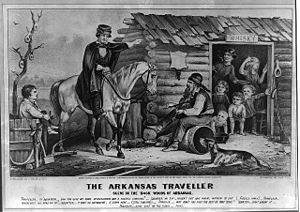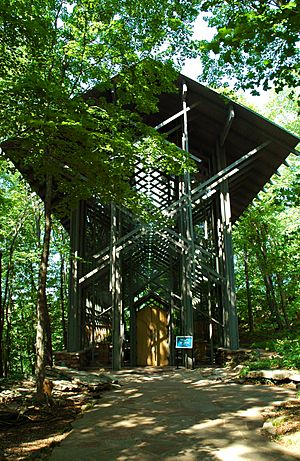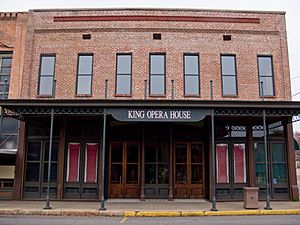Culture of Arkansas facts for kids
The culture of Arkansas is a special blend of traditions from different groups. It mixes the cultures of early European settlers with those of Native Americans and people from Africa. This Southern culture is still very strong in rural parts of Arkansas, especially in the Arkansas delta and southern areas. Arkansas shares a history with other Southern states, including important events like the American Civil War, the time of Reconstruction, and the Civil Rights Movement.
Arkansas's culture can be seen in its books, music, sports, movies, TV shows, and art. Famous people from Arkansas include authors like Maya Angelou and John Grisham, and musicians like Johnny Cash. People in Arkansas also love football, hunting, and fishing. The state has inspired many artists and has been featured in films and TV shows.
Contents
People and Their Way of Life
People in Arkansas are known for their polite manners and for being very religious. The way people speak in Arkansas includes several different Southern American English accents. The state's economy also shapes its culture. Food is a big part of Arkansas's culture, with popular dishes like barbecue, fried catfish, fried chicken, and grits.
Arkansas's Reputation
Arkansas sometimes has a stereotype of being a rural, poor, "hillbilly" state. This image often includes ideas of people playing banjos or being uneducated. This "hillbilly" reputation is a big part of Arkansas's culture. Some Arkansans try to correct this image, while others embrace it. The Old State House Museum even had an exhibit about the state's reputation in 2012.
How the Image Started

Arkansas's image today grew from early writings by visitors to the state. During the frontier days, many explorers wrote about their travels in the new western parts of the United States. They sent their notes back East. Some early writers described Arkansas as a wild place with rough people. They also noted that people in frontier Arkansas were very self-sufficient and skilled at survival. This kind of description was common for many frontier states. However, because travelers didn't pass through Arkansas as much later on, these early comments stuck in people's minds.
The image continued to grow with funny stories about poor white people, especially in the hill country. The most famous symbol of Arkansas's "hillbilly" image is The Arkansas Traveller. This is a painting based on a folk tale from the 1840s. The story is about a politician who gets lost in the Ozarks and asks for directions at a cabin. The man at the cabin keeps playing his banjo and avoids answering questions. Eventually, he feeds the group and lets them stay the night. This story was meant to show the difference between rich plantation owners in southeastern Arkansas and poor people in the northwestern hill country. But over time, it changed to show a Northerner lost in the Ozarks asking a "backwoods" Arkansan for help. The legend became even more popular with a play and a humor magazine.
Historical Impact on Image
Arkansas's image is also shaped by its history of challenges related to racial integration. Like other former slave states, Arkansas faced social difficulties. Events like the Little Rock Nine crisis at Central High School in Little Rock made many people think of Arkansas as a state that resisted racial integration for many years. Often, the Little Rock Nine crisis is one of the few things mentioned about Arkansas in history books. This has helped shape opinions and continued the state's negative reputation for some time.
Southern Accents in Arkansas
Many Arkansans speak with a Southern accent. It's often described as an Upper South accent, similar to those in nearby Oklahoma and Texas. This is different from the Deep South accent found in southeastern Arkansas, like the Arkansas Delta. The accent helps Arkansans feel connected to Southern culture. However, people from other regions sometimes use the Southern accent to link Arkansas to stereotypes of being uneducated.
Stories exist about people from the North disrespecting those with Southern accents. This often comes from how the South is shown in popular movies and TV shows. A language expert named Rosina Lippi noted that Northerners sometimes use the Southern accent to make fun of the South. Since Southerners are connected by culture and history, not race, some people use the accent to bring up stereotypes that might otherwise be uncomfortable to discuss, such as those related to racism. This belittling of Southern accents has led to classes being offered for people who want to lose their Southern accent before moving to work in the North.
Food and Drink

Arkansas is located near three famous barbecue regions: Memphis, Texas, and Kansas City. Because of this, Arkansas has a mix of barbecue styles across the state, rather than just one "Arkansas style." This blend is sometimes called the "Mid-South style." Many early settlers in the Arkansas Delta came from Tennessee and Virginia, bringing their barbecue traditions with them. Barbecues were community events in the Delta, even used by politicians to meet voters. Early barbecues in Arkansas involved digging trenches in the woods, filling them with hot coals from oak and hickory wood. They would cook whatever animals the community offered, like cows, pigs, chickens, and deer.
Smoking meat was very important for early settlers to keep food fresh. The smokehouse was one of the most important buildings on an Arkansas farm. Hog hunts and pig roasts were also community events in early Arkansas.
Popular restaurant dishes include pulled pork and chicken sandwiches, brisket, and ribs. These are served with traditional side dishes. BBQ chicken is very popular in the Ozarks, where there's a long history of raising poultry. Some BBQ restaurants, like McClard's Bar-B-Q in Hot Springs, are also known for hot tamales.
Other traditional meat dishes include hamburger steak with gravy and onions, and fried foods like chicken fried steak, fried chicken, and catfish.
Side Dishes and Condiments
Louis Jordan from Brinkley, Arkansas, was a famous musician in the mid-1900s. Several of his songs mention traditional Arkansas dishes, like "Beans and Corn Bread" and "Cole Slaw (Sorghum Switch)". Common side dishes include corn bread, greens, potato dishes (like baked potatoes or French fries), macaroni and cheese, salads (fruit, garden, or potato), coleslaw, corn, and fried vegetables like okra or pickles.

Cheese dip, sometimes called queso, was first made at Mexico Chiquito in North Little Rock, Arkansas. Little Rock hosts an annual World Cheese Dip Championship. Many restaurants in Central Arkansas offer their own special recipes. The Arkansas Department of Parks & Tourism even has a Cheese Dip Trail with 19 stops across the state. In 2016, Arkansas cheese dip won a taste test against Texas-style queso among US Senators.
Sweets
Early Arkansas settlers used honey bee honey and sorghum to sweeten their food. Store-bought sugar or candy was rare. Farmers would find bee hives and keep the bees in special "bee gums" made from trees. Almost every early farmer grew sorghum to make molasses, which they used as a sweetener when honey ran out. Fall sorghum harvests were community events at the local sorghum mill.
Sugar maple trees grow in the hills of the Ozarks. People collect sap (often called "water" there) from these trees, similar to how it's done in Vermont or Canada. This sap is boiled down to make syrup. It takes about 43 gallons (163 liters) of sap to make 1 gallon (3.8 liters) of syrup. For many in the Ozarks, making maple syrup is a family tradition. It often involves camping in the woods and other family gatherings.
-
Governor Asa Hutchinson (left) and US Representative Mike Ross (second from left) at the watermelon eating competition in Hope.
Restaurants
Little Rock's Lassis Inn was an important meeting place for civil rights leaders in the 1950s and 60s. People like Daisy Bates met there to plan efforts such as the desegregation of Little Rock Central High School. In 2017, it was one of the first three places added to the Arkansas Food Hall of Fame. In 2020, it was named an America's Classic by the James Beard Foundation.
Arts and Creativity
Architecture
The buildings in Arkansas show a wide variety of styles. Architecture can be divided into two main types: traditional folk houses and buildings designed in specific styles.
The history of architecture in Arkansas is similar to that of the rest of the country. In the 1800s, three styles were popular: French Colonial, Federal, and Greek Revival. Later in the 1800s, Gothic Revival, Italianate, and Second Empire became popular. Near the turn of the century, buildings often used the Queen Anne and Romanesque Revival styles. Charles L. Thompson was a very active architect in Arkansas during this time. His company designed over 2,000 buildings in the state. Today, 143 of his firm's older buildings are listed on the National Register of Historic Places.
In the 20th century, many new styles became popular in Arkansas. These included American Craftsman, Classic Revival, Colonial Revival, Prairie School, and Tudor Revival. Later, Art Moderne and Art Deco styles appeared. E. Fay Jones created unique buildings that blended with nature, like Thorncrown Chapel and Mildred B. Cooper Memorial Chapel. Most recent buildings in Arkansas are built in a modern style. Early settlers built simple log cabins and shacks using materials they found nearby.
Literature
Early books about Arkansas, written soon after it became a state in 1836, sometimes described it as a wild place with lazy farmers. Arkansas was also often featured in "Southwest humor" stories. These stories used exaggeration to be funny. Some of these images stuck in people's minds and are partly responsible for the "Arkansas hillbilly" stereotype that is still sometimes used today. Books by Arkansas natives often show the state's diverse landscapes. The culture of rural Arkansas towns is seen in works like I Know Why the Caged Bird Sings by Maya Angelou (set in Stamps, Arkansas) and John Grisham's A Painted House (set in Black Oak, Arkansas). The University of Arkansas Press is the state's largest book publisher.
Music
Performing Arts
Arkansas has several theaters for performing arts. These include the Walton Arts Center in Fayetteville, the Arkansas Public Theatre in Rogers, the Robinson Center in Little Rock, and the King Opera House in Van Buren. The Arkansas Arts Council helps touring performers and provides money for the performing arts. Arkansas Repertory Theatre, in Little Rock, is the state's largest non-profit theater company. Northwest Arkansas also has TheatreSquared, which is the only year-round theater in the region. TheatreSquared has been recognized by the American Theatre Wing and focuses on teaching arts to young people, in addition to its many performances each year.
Little Rock is home to the Arkansas Repertory Theatre, the Arkansas Symphony Orchestra, and Ballet Arkansas. The Arkansas Arts Center in downtown Little Rock is the state's main arts center. It has famous artworks by artists like Rembrandt, Pablo Picasso, and Edgar Degas. Across the Arkansas River, the Argenta Arts District has a community theater, studios, and art galleries.
You can find Folk music and traditional Ozark performances at Ozark Folk Center State Park in Mountain View. Folk dances, like square dances and hoedowns, were very popular in early Arkansas.
Museums
Museums in Arkansas show and protect the state's culture for future generations. From fine art to history, there are museums all over Arkansas. The most popular museum is Crystal Bridges Museum of American Art in Bentonville. It was funded by Alice Walton and had over 604,000 visitors in its first year, 2012. The museum is near Downtown Bentonville and has walking trails and learning opportunities. It displays over 450 artworks covering five centuries of American art. Other art museums in Arkansas include the Arkansas Arts Center in Little Rock and the South Arkansas Arts Center in El Dorado.
History museums teach about the state's past to both Arkansans and tourists. The National Park Service (NPS) manages sixteen historic places in the state. This includes Arkansas Post National Memorial, which tells the story of the first European settlement in Arkansas. The NPS also has history museums at Bathhouse Row, Central High School National Historic Site, Fort Smith National Historic Site, and Pea Ridge National Military Park.
The Department of Arkansas Heritage runs four different museums in Arkansas. These include the Delta Cultural Center in Helena-West Helena, and the Historic Arkansas Museum, the Old State House (Little Rock), and the Mosaic Templars Cultural Center, all in Little Rock. The Arkansas Department of Parks and Tourism operates the Arkansas Museum of Natural Resources in Smackover. The department also manages eight historic state parks: Hampson Archeological Museum State Park, Jacksonport State Park, Lower White River Museum State Park, Davidsonville Historic State Park, Historic Washington State Park, Parkin Archeological State Park, Powhatan Historic State Park, and Toltec Mounds Archeological State Park. Other history museums, like the Grant County Museum in Sheridan and the Shiloh Museum of Ozark History in Springdale, work to save important local and regional history.
Sports and Recreation
Sports are a big part of Arkansas's culture. People enjoy playing and watching various events all year. One of the oldest sports in Arkansas is hunting. After the American Civil War, guns became easier and cheaper to get. This allowed many Arkansans to hunt together in camps. These hunting groups often traveled through the wilderness, eating well and having fun. In 1915, the state created the Arkansas Game and Fish Commission to manage hunting. Today, many Arkansans hunt animals like duck and deer. Tourists also come to the state to hunt. Fishing has always been popular in Arkansas. The sport has grown thanks to the creation of many reservoirs across the state. After the Norfork Dam was built, the Norfork Tailwater and the White River became popular places for trout fishing. Several smaller towns have grown because they are located on fishing lakes. The Buffalo National River is kept in its natural state by the National Park Service and is visited by fly fishers every year.
Football, especially college football, has always been important to Arkansans. This is partly because the state doesn't have a top-level professional sports team. College football in Arkansas started small. The University of Arkansas first had a team in 1894. "Calling the Hogs" is a famous cheer that shows support for the Arkansas Razorbacks, one of the two top college football teams in the state. High school football also grew in Arkansas in the early 1900s. Over the years, many Arkansans have seen the Razorbacks football team as a symbol of the state. After the Little Rock Nine integration crisis, Arkansans looked to the successful Razorback teams in the years that followed to help improve the state's image. Even though the University of Arkansas is in Fayetteville, the Razorbacks always play at least two games each season at War Memorial Stadium in Little Rock. This helps keep fan support strong in central and south Arkansas. Arkansas State University also joined the top college football division in 1992.





















